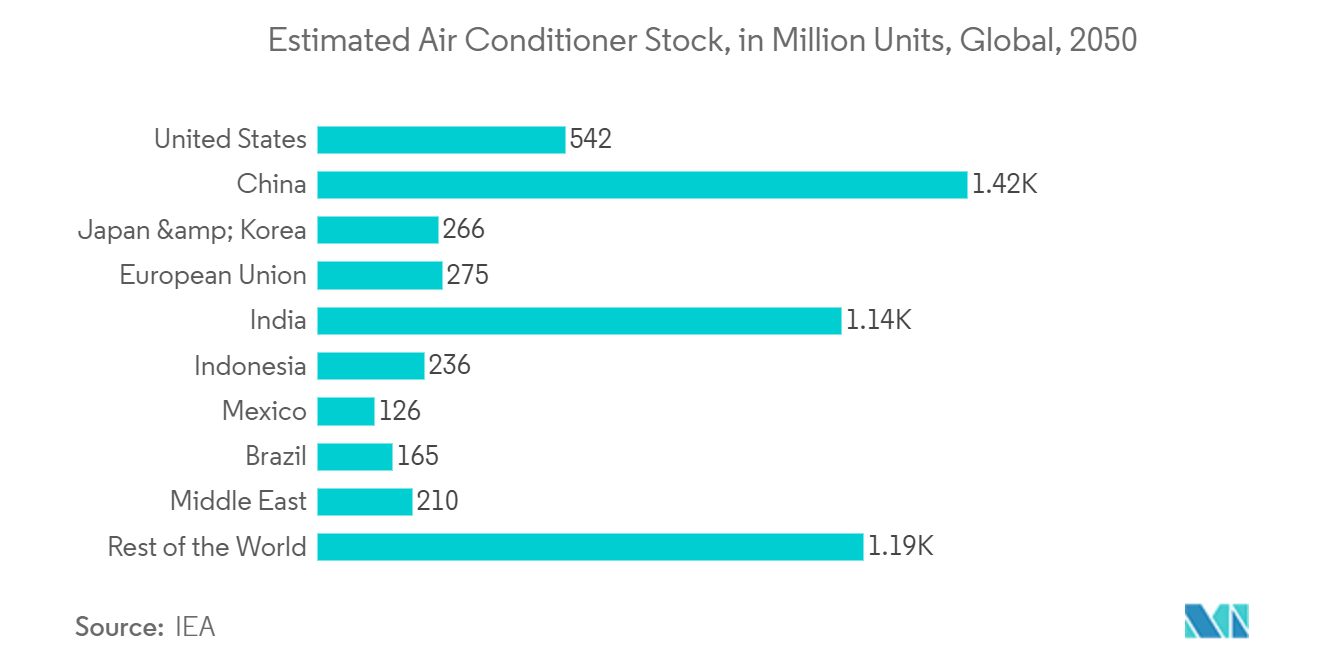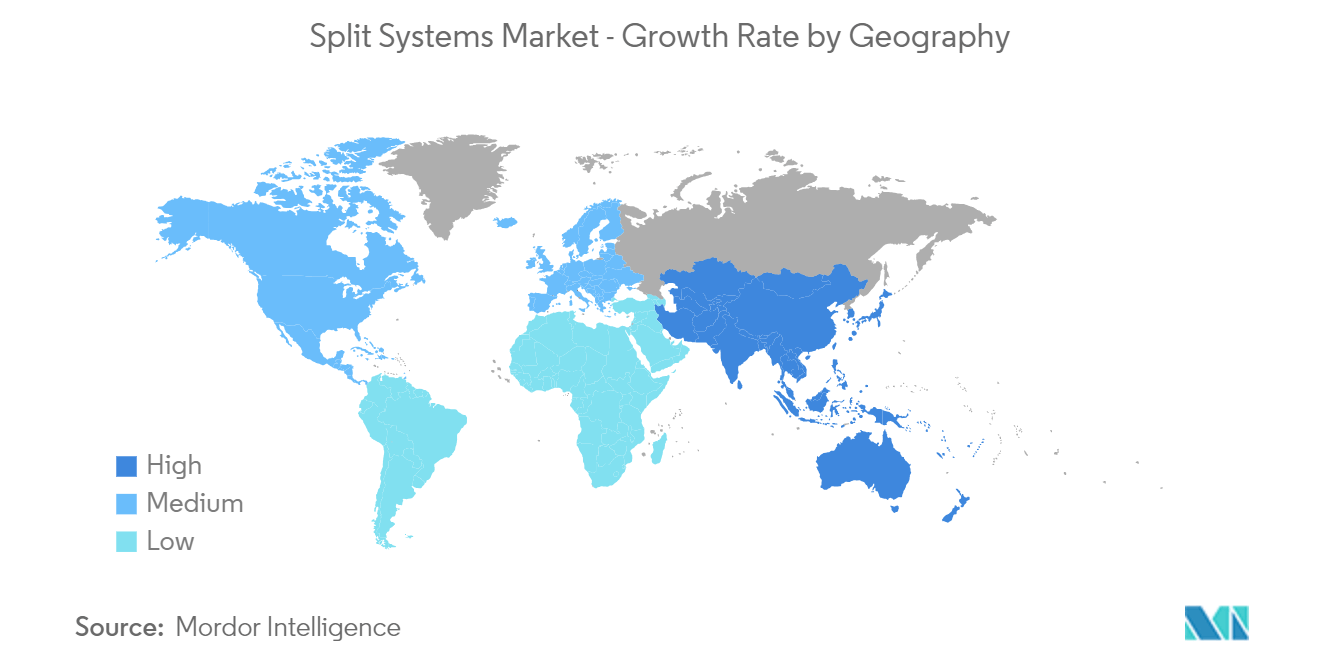Market Trends of Split Systems Industry
Residential Sector to be the Largest Application Segment
- Heating and cooling systems have been among the crucial facilities within residential spaces for years. With technology evolving, the traditional form of heating and cooling solutions has been replaced by advanced technologies such as HVAC and split systems. As a result, the segment is anticipated to continue to hold a notable presence in the studied market's context during the forecast period.
- With the global average temperature increasing and climatic conditions changing globally, the demand for space cooling and heating solutions is anticipated to grow at a significant rate during the forecast period. For instance, according to research by scientists at NASA's Goddard Institute for Space Studies (GISS), since 18,80, the earth's average global temperature has increased by at least 1.1° Celsius (1.9° Fahrenheit). Furthermore, according to the projections by the Wisconsin Department of Natural Resources, by 2050, global temperature is anticipated to increase by about 1.5 degrees Celsius (2.7° degrees Fahrenheit).
- According to the International Energy Agency (IEA), currently, about 2 billion air conditioning units are in operation globally, wherein residential operational units account for nearly 70% of the total, making space cooling one of the leading driving factors of rising electricity demand in buildings. Hence, the sector is witnessing a rising demand for energy-efficient solutions to stay on track with global initiatives such as the Net Zero Emissions by 2050 (NZE), which in turn is driving opportunities in the ductless air conditioning solutions and split systems market as these technologies helps the consumers in saving energy.
- The growing global population is driving the demand for residential units, which is also creating a favorable outlook for the studied market's growth, especially considering the economic growth of highly populous regions, including China, India, Indonesia, etc., which is enhancing the capability of consumers to spend on comfort solutions. For instance, according to Knight Frank, in 2022, about 328 thousand housing units were launched in the residential housing market across India. According to the National Property Information Centre, in 2022, new launches for residential property stood at 54,118 units in Malaysia, higher than the 43,860 units recorded in 2021.
- Similarly, according to the U.S. Census Bureau, in 2022, the value of private home construction in the United States reached USD 899.1 billion, from USD 557.56 billion in 2018. Hence, the expansion of residential spaces will drive opportunities in the studied market during the forecast period.
- According to IEA, a significant portion of homes in hot countries have not yet purchased air conditioning solutions, which is also anticipated to drive opportunities in the studied market as the increasing global temperature, population density, and economic growth will drive consumers to adopt such solutions. IEA estimates around 2/3 of the world's households will have an air conditioner by 2050, with countries with a higher population, including China, India, and Indonesia, anticipated to account for about half of the total number. These factors are expected to aid the market's growth.

Asia-Pacific is Expected to Hold Significant Market Share
- The People's Republic of China has experienced significant growth in space-cooling energy consumption over the past two decades due to rising income levels and a growing need for efficient heating and cooling. Factors such as increased spending power, a growing middle-class population, and a rise in the number of residential and commercial buildings have all contributed to the increased adoption of split systems. Furthermore, the region's investments in residential and commercial construction are expected to drive market demand.
- The market is anticipated to experience further growth due to the increasing consumer consciousness regarding energy efficiency, climate change issues, and government initiatives aimed at promoting sustainable heating and cooling solutions. China's recent introduction of the Green Cooling Action Plan (GCAP) in June 2019, which includes new energy efficiency and market penetration objectives for cooling products, is expected to drive improvements in cooling efficiency and the adoption of eco-friendly refrigerants.
- Moreover, the Global Cooling Action Plan (GCAP) has established specific objectives for China's cooling industry. By 2030, there should be a minimum 25% increase in energy efficiency for major cooling products, a 40% rise in the market share of environmentally friendly and efficient cooling products, and a 30% improvement in energy efficiency for large public buildings compared to 2022 levels. These advancements will result in a combined annual electricity savings of 400 billion kWh. Additionally, the implementation of the GCAP has led to the inclusion of cooling retrofit projects in China's Special Fund for Ecological Civilization Construction subsidy program. Such initiatives are expected to drive the market further.
- The escalating pollution levels in Japan have prompted the nation to intensify its emphasis on environmentally friendly buildings, thereby presenting numerous investment opportunities for industry participants to expand their presence in the Japanese market. As per the International Energy Agency (IEA), Japan has recently revised its building regulations, mandating zero-energy performance for all new constructions by 2030 and for all existing structures by 2050. These regulations aimed at promoting energy-efficient buildings are expected to bolster market demand.
- The demand for Split Air Conditioners in India is steadily rising each year. This growth can be attributed to the expanding middle-class population, rising temperatures due to climate change, and increasing residential and commercial structures, resulting in a higher demand for Room Air Conditioners (RAC).
- The International Energy Agency's recent policy review suggests that the Korean government's Green New Deal, if effectively executed, will expedite Korea's transition to clean energy and position the nation as a leader in future energy industries. Additionally, Korea's commitment to achieving carbon neutrality by 2050 reflects its determination to reduce reliance on fossil fuels and energy imports. Such government initiatives are expected to drive the need for energy-efficient cooling solutions, thereby driving the market.
- Space cooling is the most rapidly expanding energy consumption in buildings globally, particularly in Southeast Asia. In recent years, there has been substantial growth in the region's electricity usage for cooling purposes. The International Energy Agency (IEA) reports that merely 15% of households in Southeast Asia presently utilize air conditioning, indicating substantial potential for expansion in crucial areas. As incomes rise, energy accessibility improves, and affluence spreads, the demand for Split Acs will become increasingly affordable for a larger population in Southeast Asia, thereby creating a significant market demand.

